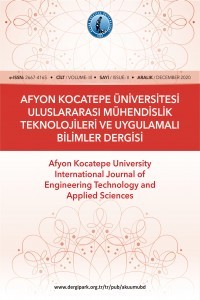Derin öğrenme tabanlı Elektrikli Ev Aletleri Veri Setinin Sınıflandırılması
Elektriğe bağlı olan her ev aletinin akım/gerilim karakteristiği farklı olduğundan, bu cihazların her birinin şebekeden çektiği gücün özelliği farklı olmaktadır. Bu nedenle şebekeye bağlı olan cihazın tipinin tespiti cihazın şebekeden çektiği harmoniğin tespit edilmesinde ve de düzeltilmesinde önemli rol oynamaktadır. Bu çalışma kapsamında farklı derin öğrenme teknikleri kullanılarak “ACS-F2 Elektrikli Ev Aletleri Veri Seti” üzerinde sınıflandırma gerçekleştirilmiştir. ACS-F2 veri setinde toplamda 15 farklı sınıf için 225 cihaz bulunmasına karşın, çalışma kapsamında yapılan ön işlemler ile veri setindeki sınıf sayısı 14’e indirilmiştir. Sonrasında LSTM, FeedForwardNet, çift yönlü LSTM( Bi-LSTM) ve parametreleri genetik algoritma tarafından optimize edilmiş Bi-LSTM kullanılarak sınıflandırma yapılarak sınıflandırıcının performansları karşılaştırılmıştır. Yapılan çalışma kapsamında parametreleri optimize edilmiş sınıflandırıcının diğer yöntemlerden daha başarılı sonuçlar elde ettiği gözlenmiştir.
Anahtar Kelimeler:
LSTM, Bi-LSTM, ev aletleri, genetik algoritma
Classification of Electrical Appliance Devices Using –Bi-LSTM and Genetic Algorithm
Since the current/voltage characteristics of each electrical appliance are different, the power consumption of devices are specific. Therefore, determining the type of electrical appliance connected to the network is crucial for the detection and correction of the device based harmonics. In this study, the classification of electrical appliances is carried out on the "ACS-F2 Electrical Appliances Dataset" using different deep learning algorithms. Although there are 225 devices for 15 different classes in the ACS-F2 data set, the number of classes in the data set has been reduced to 14 with the pre-processesing step. The LSTM, FeedForwardNet, Bi-LSTM and Ga+Bi-LSTM, models are then built to classifiy electrical appliances. It is observed that the GA+Bi-LSTM classifier, which has %94 classifiaction accuracy, overcomes among the models.
Keywords:
LSTM Bi-LSTM, Electrical Appliances, Current/voltage, Genetic Algorithm,
___
- Howell E.K. “How switches produce electrical noise,” IEEE Transactions on Electromagnetic Compatibility, no. 3, pp. 162–170, 2007.
- Patel S.N., Robertson T., Kientz J.A., Reynolds M.S. Abowd ., G.D, “At the flick of a switch: Detecting and classifying unique electrical events on the residential power line,” 9th international conference on Ubiquitous computing, Springer-Verlag, 2007, pp. 271–288.
- Hart G. W., "Nonintrusive appliance load monitoring," Proceedings of the IEEE, vol. 80, pp. 1870-1891, 1992
- Kuruppu S., Kulatunga N. A., "Smart meter based non-intrusive appliance detection algorithm for local real time feedback purposes," in Innovative Smart Grid Technologies-Asia (ISGT Asia), 2012 IEEE,2012, pp. 1-5.
- Armel K. C., Gupta A., Shrimali G., Albert A., "Is disaggregation the holy grail of energy efficiency? The case of electricity," Energy Policy, vol. 52, pp. 213-234, 2013.
- Ridi A., Gisler C., Hennebert J., “A survey on intrusive load monitoring for appliance recognition,” 22nd International Conference on Pattern Recognition (ICPR), 2014.
- Salihagic E., Kevric J., Dogru N., “Classification of ON-OFF states of Appliance Consumption Signatures” XI International Symposium on Telecommunications. 2016.
- Samira G., Rammohan M.,” Significance of Classifier and Feature Selection in Automatic Identification of Electrical Appliances” IEEE International Conference on Systems, Man, and Cybernetics, 2018.
- Hochreiter S., Jurgen S., “Long Short Term Memory” N. (1997). Journal of Neural Computation, 9(1), 1735-1780.
- Pulwer A., Liu S., “LSTM with working memory” N. International Joint Conference on Neural Networks (IJCNN)
- Jiajun L., Huazhu S., Jun L., Kaituo M., “Comprehensive analysis and classification of natural language questions based on Bi-LSTM-CRF” IEEE International Conference on Advances in Electrical Engineering and Computer Applications (AEECA)
- Dezhen Z., Kai Y., “Genetic Algorithm Based Optimization for AdaBoost”, International Conference on Computer Science and Software Engineering, 2008
- Yayın Aralığı: Yılda 2 Sayı
- Başlangıç: 2018
- Yayıncı: Afyon Kocatepe Üniversitesi
Sayıdaki Diğer Makaleler
Kolesterol Tayini için Biyosensör Geliştirilmesi
Spoyler Tasarımı ve Kullanılan ABS ve Karbon Fiber Malzemelerin Analizi
Mehmet ÇAKMAKKAYA, Furkan SOYLU
Leonarditin Hidrosiklon ile ön Zenginleştirilmesinin Alkali Liç Verimi Üzerine Etkisi
Edanur TURGUT, Züleyha DEĞİRMENCİ
Mermer Türlerinin Makine Öğrenmesi Teknikleri Kullanılarak Sınıflandırılması
Derin öğrenme tabanlı Elektrikli Ev Aletleri Veri Setinin Sınıflandırılması
Pankreas Kanserinin Erken Evrelerde Teşhisi için Yapılan Biyosensör Çalışmaları
